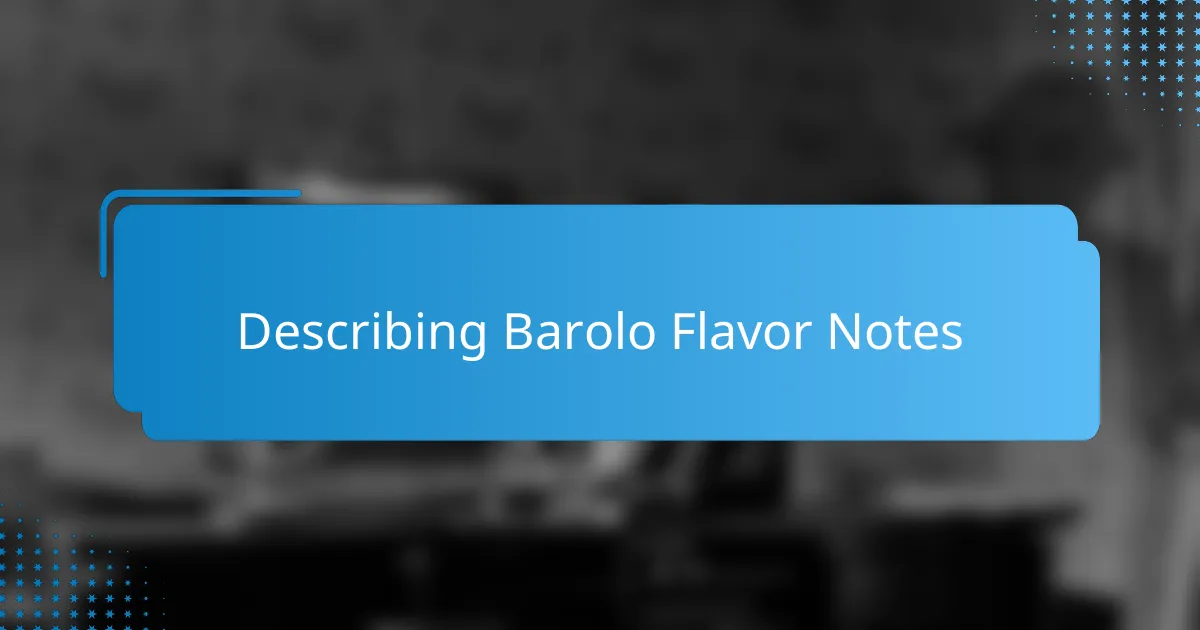Key takeaways
- Barolo, made from Nebbiolo grapes, is known for its complexity, rich flavors, and the significance of its aging process.
- The atmosphere of a wine bar enhances the tasting experience, allowing for deeper appreciation of wines like Barolo.
- Flavor notes in Barolo include ripe cherry, leather, and earthy undertones, with a balance of tannins that evolves while tasting.
- Pairing Barolo with rich foods, such as braised beef or aged cheese, elevates the tasting experience and highlights the wine’s character.

Understanding Barolo Wine Basics
Barolo is often hailed as the “King of Wines,” and rightly so. Made from the Nebbiolo grape in Italy’s Piedmont region, it boasts an intense aroma and flavors that can be both powerful and elegant. When I first tasted Barolo, I was struck by its rich complexity—notes of cherry, tar, and roses seemed to dance together in every sip.
What makes Barolo so special? It’s the unique combination of the terroir and the aging process. Barolos typically age for several years, allowing the wine to develop those bold tannins and layered flavors that linger long after the glass is empty. I remember wondering, how can one wine hold such depth and character?
Understanding these basics changed how I approached Barolo. Rather than rushing to finish the glass, I learned to savor it slowly, appreciating how its flavors evolve over time. Have you ever noticed how some wines tell a story with each sip? Barolo certainly does, inviting you to explore its richness and heritage.

Exploring Wine Bar Atmosphere
Walking into the wine bar, I immediately noticed how the atmosphere set the stage for Barolo’s grand entrance. The soft lighting and cozy seating invited me to slow down, making it easy to focus on the wine rather than distractions. Have you ever found that the right environment can heighten your tasting experience? For me, this spot felt just right.
The background buzz of quiet conversations and clinking glasses created a comforting hum, almost like the wine itself was part of a shared secret. It struck me how the staff’s passionate knowledge about Barolo added an extra layer of warmth, making the whole experience feel personal and engaging. It made me wonder—does the right atmosphere unlock deeper appreciation for complex wines like Barolo?
What stood out most was the balance between elegance and approachability in the space. It wasn’t pretentious but rather welcoming, which encouraged me to take my time with each sip. That relaxed vibe allowed me to really connect with Barolo’s rich flavors, turning a simple wine tasting into a memorable journey. Have you ever had a setting that made your wine feel more vivid? This place certainly did for me.

Selecting Barolo at Wine Bars
Choosing Barolo at a wine bar felt like stepping into a treasure hunt. I learned to look for bottles with detailed aging information on their labels—those extra years in oak barrels often mean a smoother, more complex sip. Have you ever noticed how a little patience in aging can transform a wine’s personality? It’s fascinating to see that play out in the glass.
Sometimes, I ask the sommelier for recommendations based on vintage and producer because not all Barolos are created equal. I remember a night when the server introduced me to a lesser-known estate that offered a surprisingly floral yet robust profile. That moment reminded me that embracing expert advice can lead to discovering hidden gems, making the selection feel more personal and exciting.
I’ve also found that my mood and the company I keep influence which Barolo I pick. On lively evenings, I lean towards younger, more vibrant versions, while quiet nights call for aged, velvety ones that coax out deeper reflections. Isn’t it intriguing how wine selection at a bar becomes a dialogue between the drink, the place, and yourself? Choosing Barolo here is more than a decision—it’s an experience.

Tasting Techniques for Barolo
For me, tasting Barolo starts with a careful swirl in the glass—this simple motion releases those complex aromas that are key to the experience. Have you ever taken a moment to really breathe in a wine’s scent before sipping? It’s remarkable how much the nose prepares you for the richness that’s about to unfold.
When I taste Barolo, I let it linger on my palate, paying close attention to how the flavors shift—sometimes a burst of cherry, then a hint of earthiness or spice. I find that by consciously tracking these notes, the wine’s story becomes clearer and more vivid. Isn’t it amazing how slowing down reveals layers you might otherwise miss?
One technique I never skip is pairing a small bite alongside my sip—something simple like aged cheese or cured meat. This contrast often highlights Barolo’s vibrant tannins and balanced acidity, making the flavors pop even more. I wonder, have you tried this pairing trick, and did it change how you experience Barolo’s depth? For me, it’s almost like a dance between food and wine that elevates each sip into something unforgettable.

Describing Barolo Flavor Notes
Barolo’s flavor profile is a fascinating tapestry. I often catch a wave of ripe cherry that feels both bright and velvety, quickly followed by surprising hints of leather and tar. It’s like the wine is telling a story—sometimes floral with whispers of roses, other times earthy and wild—which keeps me intrigued with every sip.
What truly captivates me is how Barolo’s tannins build structure without overpowering. There’s this firm grip at the start that gradually softens into silky waves, revealing subtle spices like clove or licorice underneath. Have you noticed how this balance makes the wine feel alive, constantly evolving as you take your time?
Sometimes, I find myself drawn to the mineral undertones, a reflection of Piedmont’s unique soils. That slight smokiness or graphite note adds a layer of complexity that feels both grounding and uplifting. Experiencing these nuanced flavors reminds me why Barolo remains one of my favorites—each bottle is a journey worth savoring.

Pairing Foods with Barolo
Pairing Barolo with food is an adventure that truly enhances its bold personality. I’ve found that hearty dishes like braised beef or mushroom risotto complement its robust tannins perfectly, creating a harmony that feels both comforting and luxurious. Have you ever noticed how a rich meal can bring out Barolo’s deeper, earthier notes in a way that’s simply unforgettable?
One evening, I paired a glass of Barolo with aged Parmigiano-Reggiano and was amazed at how the salty, nutty cheese softened the wine’s intensity, letting its floral aromas shine through. It made me realize that simple, quality ingredients often do the best justice to such a noble wine. Isn’t it fascinating how the right food can turn a good bottle into an exceptional experience?
Of course, Barolo’s acidity also calls for dishes with a bit of fat or spice, like truffle pasta or slow-cooked lamb, which balance the wine’s structure effortlessly. The interplay between bold flavors in the food and the wine’s elegance is a dance I never tire of. Have you tried pairing Barolo this way? If not, it might just redefine what food and wine pairing means to you.

Personal Experience with Barolo
There was a moment during my first Barolo tasting when the wine seemed to reveal itself like an old friend—complex yet familiar, intense yet comforting. Have you ever experienced a sip that suddenly connects you to something deeper? That night, Barolo didn’t just taste good; it sparked a genuine curiosity about its origins and craftsmanship.
I recall another evening when, sharing a bottle with close friends, the lively notes of cherry and subtle rose petals seemed to spark lively conversation and laughter around the table. It struck me how Barolo’s richness doesn’t just fill the glass—it fills the moment with warmth and connection. Isn’t that what great wine is all about?
Sometimes, I catch myself pausing mid-sip, marveling at how Barolo’s flavors unfold over time, revealing hints I missed initially. This patience taught me more than just tasting—it taught me presence. Have you noticed how a wine like Barolo can quietly change the pace of your evening, making you slow down and savor life a little more?




